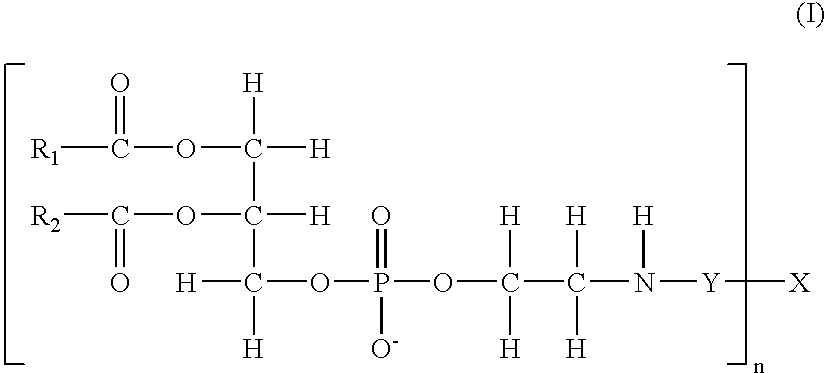Use of lipid conjugates in the treatment of diseases or disorders of the eye
a technology of lipid conjugates and eye diseases, applied in the field of eye diseases or disorders, can solve the problems of loss of vision in the elderly, vision impairment, and decreased ability to perform daily living activities, and achieve the effect of reducing incidence and severity or pathogenesis
- Summary
- Abstract
- Description
- Claims
- Application Information
AI Technical Summary
Benefits of technology
Problems solved by technology
Method used
Image
Examples
example 1
Effect of Lipid Conjugates in an In Vitro Model of Diabetic Retinopathy
[0620]Human Retinal Endothelial Cell Culture
[0621]Human eyes from donors are obtained and human retinal endothelial cells (HRECs) are isolated. The identity of HRECs is validated by demonstrating endothelial cell incorporation of fluorescence-labeled, acetylated LDL, and by fluorescence-activated cell-sorting analysis. To determine the effect of high glucose, HRECs are grown for 7 days in normal (5.5 mM) or high (25 mM) D-glucose medium.
[0622]Bovine Retinal Endothelial Cell Culture
[0623]Isolated bovine retinas are homogenized in ice-cold Eagle's minimal essential medium (MEM) with HEPES by a Teflon-glass homogenizer and microvessels trapped on an 83 mm nylon mesh. Vessels are transferred into 2×MEM containing 500 μg / ml collagenase, 200 μg / ml pronase (BDH, Poole, UK) and 200 μg / ml DNase at 37° C. for 20 min. The resultant vessel fragments are trapped on 53 μm mesh, washed with cold MEM, and centrifuged at 225×g fo...
example 2
Effect of Lipid Conjugates in an In Vivo Model of Diabetic Retinopathy
[0632]Diabetes is induced Long-Evans rats via ip streptozotocin (STZ) injections at 70-85 mg / kg, for 3 to 5 days. To help ease the transition to diabetes, the rats are given 10% sugar water for 24 hours post-STZ injection. Retinal photographs are taken and blood glucose tests are performed to determine baselines for each rat. The normal glucose range for a rat is 80-100 mg / dl.
[0633]Alternatively, C57BU6 mice (SLC, Shizuoka, Japan) are used. Postnatal day (P)7 mice with their nursing mothers are maintained for a full 5 days in 80% oxygen to generate the nonvascular retinal area. On P12, they are placed in normoxia for an additional 5 days to induce retinal neovascularization.
[0634]Each animal is glucose-tested and photographed with a fundus camera on a weekly basis to record the progression of diabetic retinopathy. Approximately 20-30 minutes prior to starting pictures, one drop of 1% atropine is placed in each eye...
example 3
Effect of Lipid Conjugates in Patients with Diabetic Retinopathy
[0642]Plasma samples are collected from Type I diabetic patients. Their grade of retinopathy is characterised according to a modified Airlie house technique: (a) no retinopathy (n=6), (b) background retinopathy (n=10), (c) proliferative retinopathy (n=6), and (d) advanced proliferative retinopathy requiring vitrectomy (n=16). Plasma samples from non-diabetic age-matched control subjects are also collected. Vitreous samples are collected from patients with advanced proliferative diabetic retinopathy prior to undergoing vitrectomy. Research Ethics Committee approval and informed consent are obtained from all patients.
[0643]Plasma and Vitreous Samples
[0644]Venous blood samples are collected from the patients and control subjects. Plasma is harvested by centrifugation, aliquoted and stored at −70° C. Approximately 0.5-1 ml of undiluted vitreous fluid is collected from the eye prior to irrigation of the vitreous, transported...
PUM
| Property | Measurement | Unit |
|---|---|---|
| pH | aaaaa | aaaaa |
| pH | aaaaa | aaaaa |
| length | aaaaa | aaaaa |
Abstract
Description
Claims
Application Information
 Login to View More
Login to View More - R&D
- Intellectual Property
- Life Sciences
- Materials
- Tech Scout
- Unparalleled Data Quality
- Higher Quality Content
- 60% Fewer Hallucinations
Browse by: Latest US Patents, China's latest patents, Technical Efficacy Thesaurus, Application Domain, Technology Topic, Popular Technical Reports.
© 2025 PatSnap. All rights reserved.Legal|Privacy policy|Modern Slavery Act Transparency Statement|Sitemap|About US| Contact US: help@patsnap.com



